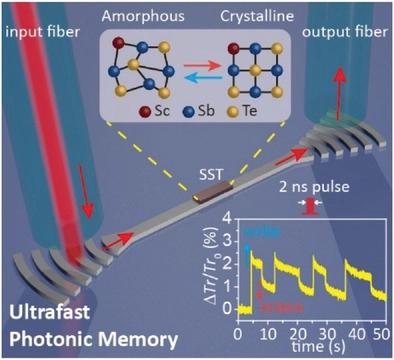当前位置:
X-MOL 学术
›
Adv. Mater.
›
论文详情
Our official English website, www.x-mol.net, welcomes your
feedback! (Note: you will need to create a separate account there.)
Neuromorphic Photonic Memory Devices Using Ultrafast, Non-Volatile Phase-Change Materials
Advanced Materials ( IF 27.4 ) Pub Date : 2022-06-17 , DOI: 10.1002/adma.202203909 Xiaozhang Chen 1 , Yuan Xue 2 , Yibo Sun 1 , Jiabin Shen 1 , Sannian Song 2 , Min Zhu 2 , Zhitang Song 2 , Zengguang Cheng 1 , Peng Zhou 1
Advanced Materials ( IF 27.4 ) Pub Date : 2022-06-17 , DOI: 10.1002/adma.202203909 Xiaozhang Chen 1 , Yuan Xue 2 , Yibo Sun 1 , Jiabin Shen 1 , Sannian Song 2 , Min Zhu 2 , Zhitang Song 2 , Zengguang Cheng 1 , Peng Zhou 1
Affiliation

|
The search for ultrafast photonic memory devices is inspired by the ever-increasing number of cloud-computing, supercomputing, and artificial-intelligence applications, together with the unique advantages of signal processing in the optical domain such as high speed, large bandwidth, and low energy consumption. By embracing silicon photonics with chalcogenide phase-change materials (PCMs), non-volatile integrated photonic memory is developed with promising potential in photonic integrated circuits and nanophotonic applications. While conventional PCMs suffer from slow crystallization speed, scandium-doped antimony telluride (SST) has been recently developed for ultrafast phase-change random-access memory applications. An ultrafast non-volatile photonic memory based on an SST thin film with a 2 ns write/erase speed is demonstrated, which is the fastest write/erase speed ever reported in integrated phase-change photonic devices. SST-based photonic memories exhibit multilevel capabilities and good stability at room temperature. By mapping the memory level to the biological synapse weight, an artificial neural network based on photonic memory devices is successfully established for image classification. Additionally, a reflective nanodisplay application using SST with optoelectronic modulation capabilities is demonstrated. Both the optical and electrical changes in SST during the phase transition and the fast-switching speed demonstrate their potential for use in photonic computing, neuromorphic computing, nanophotonics, and optoelectronic applications.
中文翻译:

使用超快、非易失性相变材料的神经形态光子存储器件
不断增长的云计算、超级计算和人工智能应用,以及光领域信号处理的高速、大带宽、低功耗等独特优势,激发了人们对超快光子存储器件的探索。能源消耗。通过将硅光子学与硫族化物相变材料(PCM)相结合,开发出非易失性集成光子存储器,在光子集成电路和纳米光子应用中具有广阔的前景。虽然传统 PCM 的结晶速度较慢,但掺钪碲化锑 (SST) 最近已开发用于超快相变随机存取存储器应用。展示了一种基于 SST 薄膜的超快非易失性光子存储器,写入/擦除速度为 2 ns,这是集成相变光子器件中迄今为止报道的最快写入/擦除速度。基于 SST 的光子存储器在室温下表现出多级功能和良好的稳定性。通过将记忆级别映射到生物突触权重,成功建立了基于光子记忆器件的人工神经网络用于图像分类。此外,还演示了使用具有光电调制功能的 SST 的反射纳米显示器应用。SST 在相变过程中的光学和电学变化以及快速切换速度都证明了它们在光子计算、神经形态计算、纳米光子学和光电应用中的潜力。
更新日期:2022-06-17
中文翻译:

使用超快、非易失性相变材料的神经形态光子存储器件
不断增长的云计算、超级计算和人工智能应用,以及光领域信号处理的高速、大带宽、低功耗等独特优势,激发了人们对超快光子存储器件的探索。能源消耗。通过将硅光子学与硫族化物相变材料(PCM)相结合,开发出非易失性集成光子存储器,在光子集成电路和纳米光子应用中具有广阔的前景。虽然传统 PCM 的结晶速度较慢,但掺钪碲化锑 (SST) 最近已开发用于超快相变随机存取存储器应用。展示了一种基于 SST 薄膜的超快非易失性光子存储器,写入/擦除速度为 2 ns,这是集成相变光子器件中迄今为止报道的最快写入/擦除速度。基于 SST 的光子存储器在室温下表现出多级功能和良好的稳定性。通过将记忆级别映射到生物突触权重,成功建立了基于光子记忆器件的人工神经网络用于图像分类。此外,还演示了使用具有光电调制功能的 SST 的反射纳米显示器应用。SST 在相变过程中的光学和电学变化以及快速切换速度都证明了它们在光子计算、神经形态计算、纳米光子学和光电应用中的潜力。









































 京公网安备 11010802027423号
京公网安备 11010802027423号